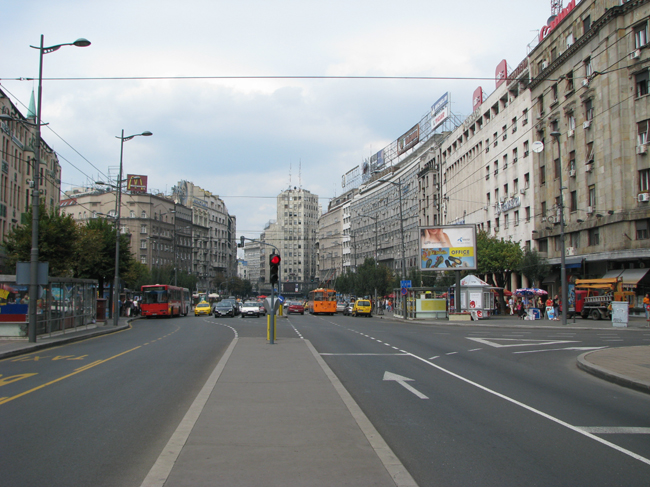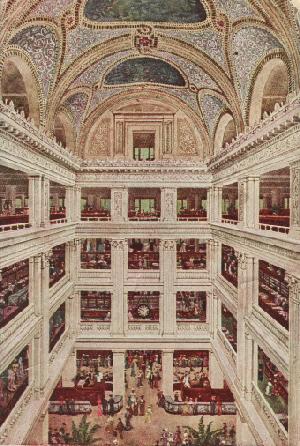|
Knez Mihailova
Knez Mihailova Street (, officially: ) is the main pedestrian and shopping zone in Belgrade, and is protected by law as one of the oldest and most valuable landmarks of the city. Named after Mihailo Obrenović III, Prince of Serbia, it features a number of buildings and mansions built during the late 1870s. One kilometer long Knez Mihailova Street was protected in 1964 as the spatial cultural-historical unit, the first cultural monument of that type in Belgrade. In 1979 it was elevated to the Spatial Cultural-Historical Units of Great Importance, and as such is protected by the Republic of Serbia. History Roman period The street follows the central grid layout of the Roman city of Singidunum, as one of the main access roads to the city corresponds to the modern street today. The main axis of urban development was along the street, which was the main route of communication (''via cardo''). The original earthen and wooden fort stretched around the Studentski Trg and Knez M ... [...More Info...] [...Related Items...] OR: [Wikipedia] [Google] [Baidu] |
Mihailo Obrenović
Mihailo ( sr-cyr, Михаило) is a South Slavic masculine given name. It is a variant of the Hebrew name ''Michael'', and its cognates include Mihajlo and Mijailo. Common as a given name among Serbs, it is an uncommon surname. Notable people with the name include: * Mihailo Vojislavljević (–d. 1081)), King of Duklja * Mihailo Ovčarević (), Habsburg Serb commander * Mihailo Đurić (1925–2011), Serbian philosopher, retired professor, and academic * Mihailo Janković (d. 1976), Serbian architect * Mihailo Jovanović (b. 1975), Serbian footballer * Mihailo Lalić (1914–1992), Montenegrin and Serbian novelist * Mihailo Marković (1927-2010), Serbian philosopher * Mihailo Merćep (1864–1937), Serb flight pioneer * Mihailo Obrenović (1823–1868), Prince of Serbia * Mihailo Petrović Alas (1868–1943), Serbian mathematician and inventor * Mihailo Petrović (Chetnik) (1871-1941), Serbian archpriest and freedom fighter * Mihailo Vukdragović (1900–1967), Se ... [...More Info...] [...Related Items...] OR: [Wikipedia] [Google] [Baidu] |
Terazije
Terazije ( sr-Cyrl, Теразијe) is the central town square and the surrounding neighborhood of Belgrade, Serbia. It is located in the municipality of Stari Grad, Belgrade, Stari Grad. Today, Terazije has primarily function of the main transit square, surrounded by the important public buildings, cultural institutions, hotels, public monuments and parks. Though not classically shaped square, Terazije was historically important as the gathering spot and the former business and commercial center of Belgrade. With the Knez Mihailova Street, which extends to the northeast connecting directly Terazije and Belgrade Fortress, the square is one of the oldest and most recognizable ambience units of Belgrade. Due to its historical and cultural importance, Terazije was declared a protected spatial cultural-historical unit in January 2020. Location Despite the fact that many Belgraders consider the Republic Square (Belgrade), Republic Square or Kalemegdan to be the city's centerpiece ... [...More Info...] [...Related Items...] OR: [Wikipedia] [Google] [Baidu] |
Lity In Eastern Christianity
The Lity or Litiyá (Greek: (Liti), from ''litomai'', "a fervent prayer") is a festive religious procession, followed by intercessions, which augments great vespers (or, a few times a year, great compline) in the Eastern Orthodox and Byzantine Catholic churches on important feast days (and, at least according to the written rubrics, any time there is an all-night vigil). Following a lity is another liturgical action, an artoklasia, and either of these terms may be used to describe both liturgical actions collectively. Procession At vespers, after the ''Prayer at the Bowing of Heads'', the procession commences: the clergy, including a deacon with a censer and, when logistically possible, the chanters, the process to the narthex of the church during which are sung stichera of the feast and/or of the patron of the church. Once the procession reaches the narthex and the stichera have been sung, the deacon begins a series of lengthy petitions (these are the "lity" proper), asking fo ... [...More Info...] [...Related Items...] OR: [Wikipedia] [Google] [Baidu] |
Department Store
A department store is a retail establishment offering a wide range of consumer goods in different areas of the store under one roof, each area ("department") specializing in a product category. In modern major cities, the department store made a dramatic appearance in the middle of the 19th century, and permanently reshaped shopping habits, and the definition of service and luxury. Similar developments were under way in London (with Whiteleys), in Paris () and in New York City ( Stewart's). Today, departments often include the following: clothing, cosmetics, do it yourself, furniture, gardening, hardware, home appliances, houseware, paint, sporting goods, toiletries, and toys. Additionally, other lines of products such as food, books, jewellery, electronics, stationery, photographic equipment, baby products, and products for pets are sometimes included. Customers generally check out near the front of the store in discount department stores, while high-end traditional d ... [...More Info...] [...Related Items...] OR: [Wikipedia] [Google] [Baidu] |
Phonograph
A phonograph, later called a gramophone, and since the 1940s a record player, or more recently a turntable, is a device for the mechanical and analogue reproduction of sound. The sound vibration Waveform, waveforms are recorded as corresponding physical deviations of a helical or spiral groove engraved, etched, incised, or impressed into the surface of a rotating cylinder or disc, called a ''Phonograph record, record''. To recreate the sound, the surface is similarly rotated while a playback #Stylus, stylus traces the groove and is therefore vibrated by it, faintly reproducing the recorded sound. In early acoustic phonographs, the stylus vibrated a Diaphragm (acoustics), diaphragm that produced sound waves coupled to the open air through a flaring Horn loudspeaker, horn, or directly to the listener's ears through stethoscope-type earphones. The phonograph was invented in 1877 by Thomas Edison; its use would rise the following year. Alexander Graham Bell's Volta Laboratory an ... [...More Info...] [...Related Items...] OR: [Wikipedia] [Google] [Baidu] |
Kafana
Kafana is a type of local coffeehouse, bistro or tavern, common in the countries of Southeast Europe, which originally served coffee and other warm drinks while today usually also offer alcoholic beverages and food. Many kafanas feature live music performances or themed nights. The concept of a social gathering place for men to drink alcoholic beverages and coffee originated coterminously in Europe and Western Asia. It became popular in the Ottoman Empire and spread to Southeast Europe during Ottoman rule, further evolving into the contemporary kafana. Nomenclature and etymology This distinct type of establishment is known by several slightly differing names depending on country and language: * (Plural, pl. ) / (pl. ) ** (), pl. ) ** () or (), pl. or ** (), pl. * (), pl. () * () or (), pl. () * , pl. * , pl. The word itself, irrespective of regional differences, is derived from the Turkish language, Turkish 'coffeehouse', which is in turn derived from the Pe ... [...More Info...] [...Related Items...] OR: [Wikipedia] [Google] [Baidu] |
čaršija
A bazaar or souk is a marketplace consisting of multiple small stalls or shops, especially in the Middle East, the Balkans, Central Asia, North Africa and South Asia. They are traditionally located in vaulted or covered streets that have doors on each end and served as a city's central marketplace. The term ''bazaar'' originates from Persian, where it referred to a town's public market district. The term bazaar is sometimes also used to refer collectively to the merchants, bankers and craftsmen who work in that area. The term ''souk'' comes from Arabic and refers to marketplaces in the Middle East and North Africa. Although the lack of archaeological evidence has limited detailed studies of the evolution of bazaars, the earliest evidence for the existence of bazaars or souks dates to around 3000 BCE. Cities in the ancient Middle East appear to have contained commercial districts. Later, in the historic Islamic world, bazaars typically shared in common certain institutions, ... [...More Info...] [...Related Items...] OR: [Wikipedia] [Google] [Baidu] |
Politika
( sr-Cyrl, Политика, lit=Politics) is a Serbian daily newspaper, published in Belgrade. Founded in 1904 by Vladislav F. Ribnikar, it is the oldest daily newspaper still in circulation in the Balkans. Publishing and ownership is published by Politika novine i magazini (PNM), a joint venture between Politika a.d. and East Media Group. The current director of PNM is Mira Glišić Simić. PNM also publishes: *''Sportski žurnal'' *''Politikin Zabavnik'' *''Svet kompjutera'' *''Ilustrovana Politika'' *''Bazar'' History Since its launch in January 1904, was published daily, except for several periods: *Due to World War I, there were no issues from 14 November 1914 to 21 December 1914, and again from 23 September 1915 to 1 December 1919. *Due to World War II, there were no issues from 6 April 1941 to 28 October 1944. *In protest against the government's intentions to turn into a state-owned enterprise, a single issue was not published in the summer of 1992. The launc ... [...More Info...] [...Related Items...] OR: [Wikipedia] [Google] [Baidu] |
Thoroughfare
A thoroughfare is a primary passage or way of transport, whether by road on dry land or, by extension, via watercraft or aircraft. Originally, the word referred to a main road or open street which was frequented thoroughly. Different terms *Roads, route or way on land between two places that has been paved or otherwise improved for travel * Boardwalk * Boulevard, particularly in North American usage * Bridle path, for equestrian use * Canopy walkway * Cycleway, for use by cyclists *Footpath, for use only by pedestrians * Foreshoreway, a greenway along the edge of the sea, open to both walkers and cyclists * Greenway, a wilderness area intended for "passive use" * Highway, depending on jurisdiction, anything from a path (England) to a road restricted to fast motor vehicles * Hiking trail, trails (footpaths), in the countryside *Long-distance trail, recreational trail of exceptional length (between 50 km and 1,000 km or more) mainly through rural areas used for hiking, backpacking, ... [...More Info...] [...Related Items...] OR: [Wikipedia] [Google] [Baidu] |
Venčac
Venčac (Serbian Cyrillic: Венчац) is a mountain in central Serbia, near the town of Aranđelovac. Its highest peak has an elevation of 659 meters above sea level. It is well known by its mine of white marble. See also *Bukulja Bukulja (Serbian Cyrillic: Букуља, ) is a mountains of Serbia, mountain near Aranđelovac in central Serbia. This mountain is an extinct volcano, which has been proved by presence of granite rocks, which contains specific mineral compositi ... References External links Vencac marble mine Mountains of Serbia {{Serbia-geo-stub ... [...More Info...] [...Related Items...] OR: [Wikipedia] [Google] [Baidu] |
Aleksandar Deroko
Aleksandar Deroko ( sr-Cyrl, Александар Дероко; 4 September 1894 – 30 November 1988) was a Serbian architect, artist, and author. He was a professor of the Belgrade University and a member of the Serbian Academy of Sciences and Arts. Biography His great-grandfather was a Venetian named Marco de Rocco, who moved to Dubrovnik (in the Kingdom of Dalmatia) and married a local woman. Aleksandar's grandfather, Jovan, came to Belgrade to be an art teacher. On his maternal side, his great-uncle was Jovan Đorđević (1826–1900), the founder of the Serbian National Theatre in Novi Sad. Deroko was also related to the famous Serbian writer Stevan Sremac (1855–1906). During his childhood years, his family lived in his great-uncles' house at Knez Mihailova Street, in the center of Belgrade. He was not a very good student in elementary and secondary school, in fact he barely managed to graduate. As he said in his biography, he preferred boating on the river Sava to s ... [...More Info...] [...Related Items...] OR: [Wikipedia] [Google] [Baidu] |





